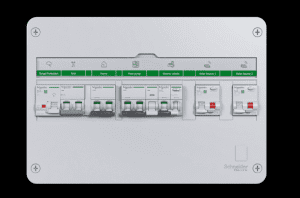The data center industry has achieved impressive sustainability gains over the past decade – mostly focused on operational efficiency. However, relatively little attention has been paid to the environmental impact of data center construction, and in particular to the embodied carbon of the materials and equipment that go into a new data center build.

The importance of addressing embodied carbon
The term “embodied carbon” refers to the greenhouse gases (GHGs) released throughout the supply chain of a material or product. This concept is gaining increased attention from both industry and government as organizations work to drive down its significant impact on facility emissions. For example, Microsoft has calculated that the embodied carbon of capital goods makes up 18% of its total corporate emissions. Amazon puts this figure at 17%, and for Meta it’s a full 45% of the company’s entire emission footprint.
Embodied carbon must be calculated and addressed to drive down these numbers in the design phase. Operational efficiency can be improved through retrofit and operational change during the life of a data center. In contrast, once a data center is built, the embodied carbon of its constituent materials and parts is locked in.
Thinking about cement and steel
The two most significant contributors to embodied carbon in buildings are concrete and steel. Concrete often accounts for as much as 40% of the material for a data center’s construction, while steel – both reinforcement and structural – can account for 10% of a project’s construction material. It is estimated that sourcing sustainably made concrete and steel can yield carbon emissions savings of up to 13% in a data center construction project.
The Global Cement and Concrete Association has committed to zero emissions concrete by 2050, but that is a long journey and relies heavily on the deployment of carbon capture and storage to mitigate its process emissions. However, other companies working on low carbon solutions such as CarbonCure reduce the emissions by injecting waste CO2 into the mix. CarbonCure aims to remove 500 megatons of CO2 annually from the concrete industry by 2030.
Data center design with sustainability in mind
The earlier the issue of embodied carbon can be raised, the greater the opportunity for reduced emissions. However, it can be challenging to insert sustainability concerns into a design process driven by mission-critical imperatives.
Standardization is one strategy for successfully integrating low carbon options into data center designs. It is already the norm in the industry to standardize on one design at a time, so it is important to ensure that embodied carbon accounting and preference for low carbon alternatives are written into the specification for each vendor. Once low carbon practices and standards have been established at one facility, they should be easy to replicate across future facilities.
The best way to minimize the embodied carbon associated with a new build is to avoid building new completely. Constructing a new facility creates eight times more carbon than upgrading or repurposing an existing data center or another facility.
An analysis completed by design firm HKS on ServerFarm’s refurbishment facility helped quantify the savings potential. HKS examined an existing data center in Chicago, Illinois, that is six stories tall and includes data halls, office spaces, electrical equipment, and other auxiliary spaces. The Whole Building Life-Cycle Analysis found that reusing this building eliminated the embodied carbon emissions for a standard new construction building by an estimated 88%. The elimination of the embodied carbon associated with building reuse is equivalent to the operational carbon of 200 server cabinets operating in a year.
A sustainable path forward in data center design
To better understand how to address embodied carbon in data center builds, access Schneider Electric’s and DCD’s new eBook, “The Sustainability Challenge.” In Chapter Two of this eBook, you will learn about data center construction best practices and how to integrate sustainability into each step of the process. This chapter offers practical insights to reduce emissions and optimize resources, from the optimal way to design and source sustainable materials to how to address the e-waste leaving the data center facility.


